Coastal shoreline loss has forced many local, state, and federal entities to prioritize the characterization of offshore sand resources needed for coastal resilience projects. At the same time, evaluating these resources for domestic sources of economic minerals (i.e., heavy mineral sands with Ti, Zr, rare earth elements- REEs) is an important priority for the United States and is critical for our economy, national security, infrastructure, and energy needs. The work presented here highlights the potential for an unconventional critical mineral resource and co-product of offshore sand used for beach nourishment in Virginia.
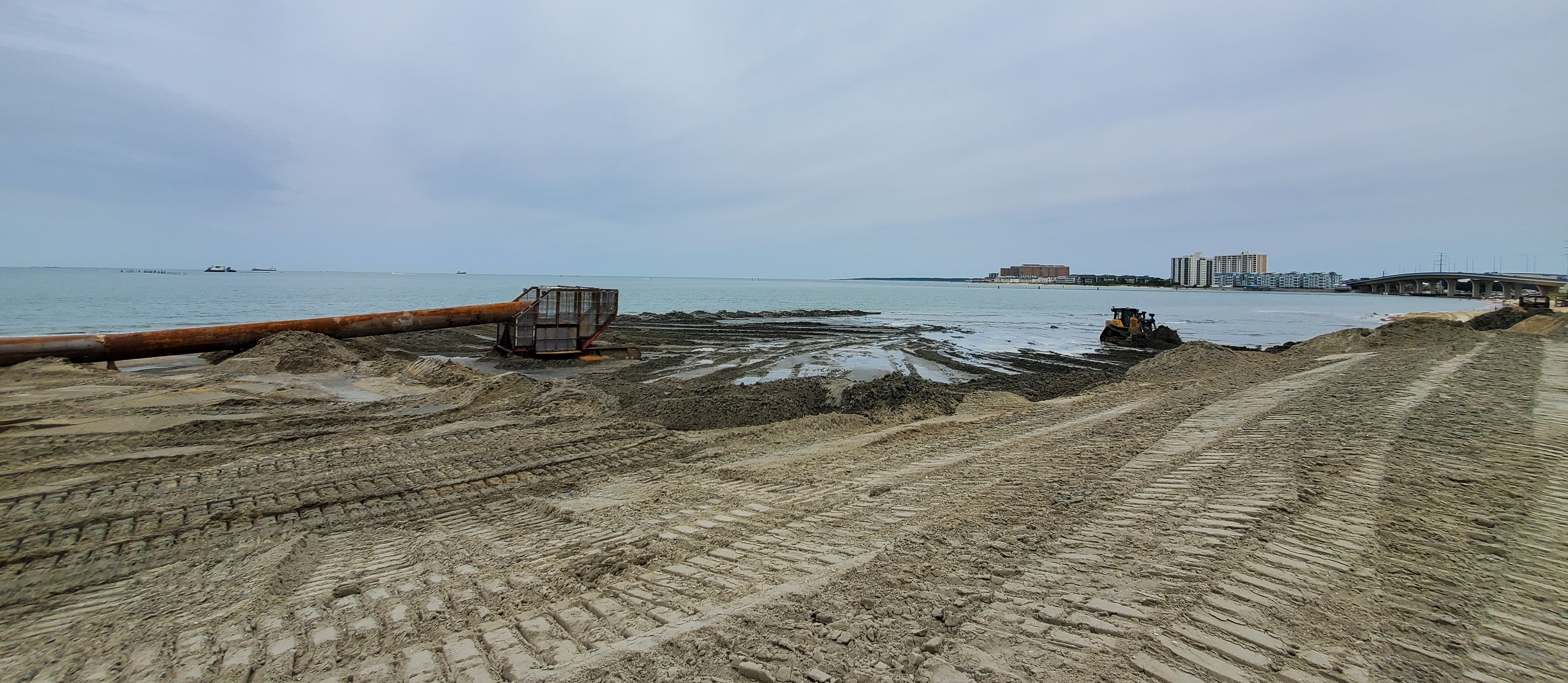
Active beach nourishment operation at Ocean Park Beach, VA (June 2022).
How We are Studying Offshore Sand Resources
The Geology and Mineral Resources Program at the Virginia Department of Energy (VA Energy) has been studying offshore sand resources over the last four decades and these projects were made possible through collaborative research opportunities with the Bureau of Ocean Energy Management (BOEM). BOEM manages federal offshore resources, including marine minerals such as sand and gravel. VA Energy has prioritized investigations of sand resource potential offshore of Virginia. A report from 2019 provides the latest information on thickness, lateral extent, and textural characteristics of potentially valuable deposits of beach-quality sand that could be utilized to support coastal resilience projects (OFR 2019-02 ).
While offshore quartz-rich sand resources provide much needed material for eroding coastlines, they also include small amounts of heavy mineral sands. These heavy mineral sands contain critical minerals that can help fulfill the objectives of Federal Executive Order 13817 (2017) aimed at securing the nation's vital materials for both security and economic prosperity. However, current understanding of offshore heavy mineral sand occurrences and co-extraction methods from marine sand deposits remains incomplete and untested. The new data release by Nelson, Hawkins, and Lassetter (OFR 2024-16) provides detailed information on potential economic heavy mineral sands that occur within marine sand deposits used in coastal resilience projects. This capacity assessment serves as a comprehensive summary of investigations related to critical commodities found in marine heavy mineral sands offshore on Virginia's Outer Continental Shelf.
resources to support Coastal Resilience
Sand and gravel deposits are mined on land for natural aggregate and serve as vital material for construction activities in our communities. The supply and availability of onshore sand and gravel resources is constrained by several factors, most importantly the increasing costs of transporting material from the mine source to the end user, typically by truck or rail. Offshore sources of material located on the continental shelf in state and federal waters can be dredged and transported at relatively lower costs and can meet the increasing demands for larger quantities of sand. Offshore sand deposits also serve as emergency reserves for coastal restoration following natural disasters and help to provide mitigative measures against long-term shoreline erosion. This is especially critical in our coastal communities that face growing risks from tidal flooding, erosional damages caused by increased storm frequency and duration, and accelerated sea level rise.
Shoreline stabilization is a major concern in many areas of coastal Virginia, and various methods to accomplish this have included the construction of structural controls and barriers such as seawalls, groins, and breakwaters. In recent years, a more natural "living shoreline" approach has utilized vegetation plantings to enhance dune formation, and beach sand replenishment. Also known as "beach nourishment", sand from a source area that meets certain textural and compositional requirements is dredged and transported to a beach that has been severely impacted by erosion. The source areas may include material dredged as part of channel maintenance, or from known sand deposits in state and federal waters. It is important to note that beach nourishment does not stop the erosive forces of the ocean, but rather provides a cost-effective means of reducing the risks associated with storms and flooding.
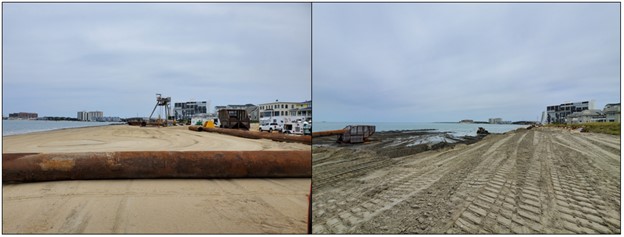
Active beach nourishment operation at Ocean Park Beach, VA (June 2022)
Marine sand deposits occur in a variety of settings including submerged shoals, lenticular sand sheets, and buried alluvial channels. Sand bodies that are considered suitable for dredging are identified based on economic factors including the thickness and lateral extent of recoverable material, grain size and shape characteristics, suitable mineralogy, distance from shore, and the thickness of overburden. Equally important are environmental considerations to ensure the protection of sensitive benthic communities, marine faunal and floral habitats, minimizing post-dredging impacts on ecosystem services, and avoidance of archaeological and other restricted sites (military use, underwater cables, pipelines, etc.). The Federal Outer Continental Shelf Lands Act (OCSLA) authorizes BOEM to lease and regulate marine minerals seaward of the State-Federal boundary line located three nautical miles (nm) from shore. Recently completed work provides new information about the thickness, lateral extent, and textural characteristics of potentially valuable deposits of clean, beach-quality sand that could be utilized to support coastal resilience projects (Figure 1; OFR 2019-02). Additional targeted sampling and geophysical data for offshore sand, gravel, and shell aggregate resources would provide data needed to help characterize sufficient areas that could be utilized for coastal resilience projects, benefiting local, state, and federal government stakeholders as well as private land holders.
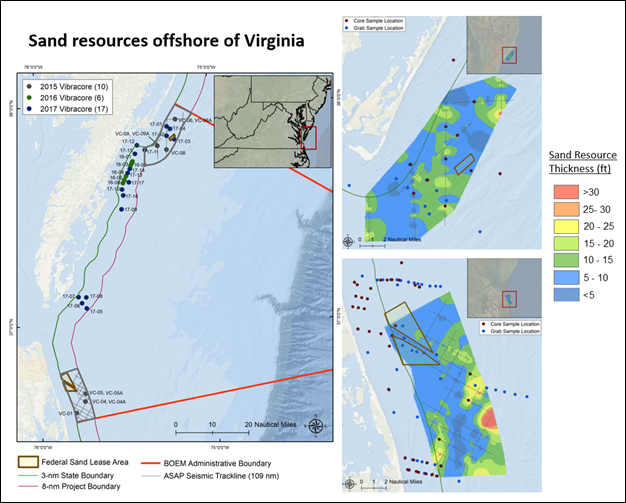
Figure 1: Sample locations and surficial sand thickness maps for areas offshore of Virginia.
Economic Heavy Minerals
Our studies have also identified economic heavy minerals that were deposited with offshore marine sediments in quantities ranging from trace amounts to over 10 percent by weight (wt%). Heavy minerals have a specific gravity greater than about 2.9 g/cm3 (common quartz - not a heavy mineral - has a specific gravity of 2.65), and include ilmenite (FeTiO3), leucoxene (altered ilmenite), rutile (TiO2), zircon (ZrSiO4), and monazite ((Ce,La,Y,Th)(PO4)), among others. These minerals contain critical elemental commodities such as titanium (Ti), zirconium (Zr), and rare earth elements (REE) that have commercial value and are potentially recoverable as an integral part of beach nourishment operations.
Offshore sand deposits contain disseminated heavy minerals that are sources of Ti- and Zr-oxides used in the manufacture of pigment for paints, plastics, ceramic glazes, and other industrial uses. Other minerals of potential economic interest include sillimanite minerals (Al22SiO5), garnet ((Mg, Fe, Mn, Ca)Al2Si3O12), and high-purity silica quartz (non-heavy mineral). Occurrences of these minerals reflect the geologic processes that have acted on Piedmont and Blue Ridge bedrock and sediments in Virginia's Coastal Plain. Physical and chemical weathering, erosion, sediment transport, and deposition, combined with marine processes, have sorted and re-distributed sediments on the continental shelf. An example of this marine re-working and natural density separation is shown in the photo below. Depending upon the concentration, extent, and mineral composition of these resources, economically viable deposits could be co-extracted with marine sand for beach nourishment or during other stand-alone dredging operations.
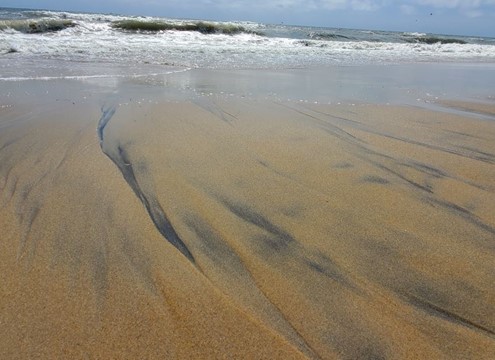
Heavy minerals (dark areas in center of photo) concentrated by wave action on Virginia Beach; location has historically received offshore sand for nourishment.
Laboratory analysis of total heavy mineral (THM) concentrates from offshore samples has allowed for the quantification of the compositional variability of economic minerals, and the concentrations of the critical commodities they contain. The results also provide new information about grain size characteristics that, together with specific gravity and magnetic susceptibility, are important for the evaluation of recovery and separation methods.
To date, Virginia Energy has analyzed mineral concentrates from 640 sediment samples for THM content. Mean THM content averaged approximately 3 wt%, with some concentrations upwards of 16 wt% THM (Figure 2). The economic heavy mineral (EHM) portion (i.e., ilmenite, rutile, zircon, REE-bearing minerals) averaged about 42% of the THM. These concentrations compare favorably with known economic grades for onshore deposits that have been historically mined in the Coastal Plain of Virginia (see the Earth MRI project page to learn more).
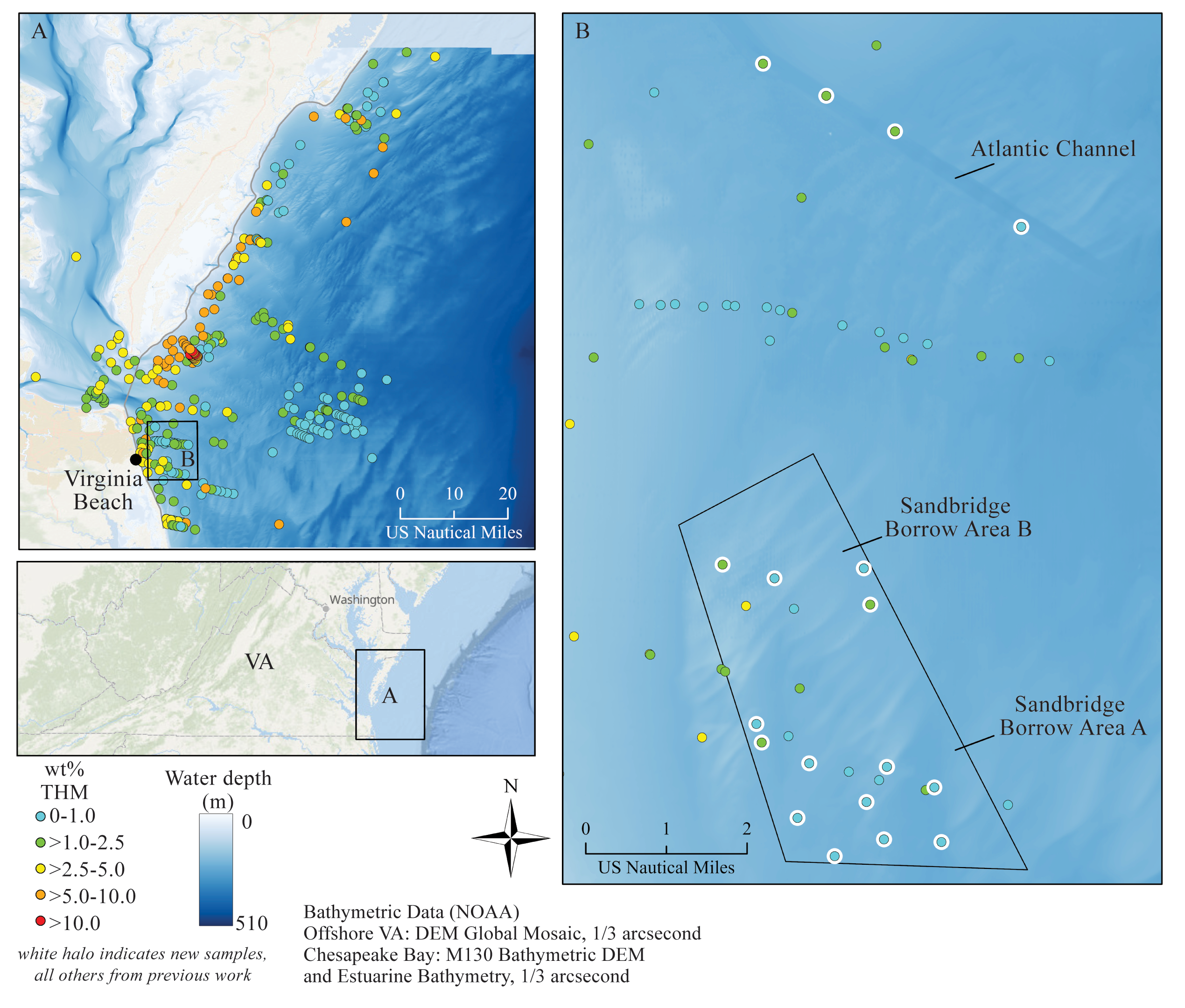
Figure 2: Heavy mineral geodatabase showing marine samples offshore of Virginia. A: 620 samples with heavy mineral data from previous projects, symbol colors determined by the percent of total heavy minerals (THM) obtained through gravity spiral separation methods. B: M21AC00010 samples (indicated with white halo) from Sandbridge Shoal and Atlantic Channel vibracores for THM and mineralogical analyses.
A capacity assessment on the recovery of critical and economic minerals from sand used for coastal resilience projects
This report was made possible through funding provided by BOEM Cooperative Agreement No. M21AC00010. It serves as a comprehensive summary of our investigation of critical commodities found in marine heavy mineral sands off the coast of Virginia, specifically delving into their potential co-extraction during beach sand nourishment operations. Five main topics are covered in the report: 1) the proceedings of the Virginia Energy Mid-Atlantic Marine Heavy Mineral Sand forum held in 2022 including the benefits and drawbacks to heavy mineral sand separation, 2) the existing regulatory requirements or lack thereof, 3) the geology of occurrences of heavy mineral sands offshore Virginia, 4) rapid screening methods for critical commodities within marine sediment using a portable x-ray fluorescence (pXRF) instrument, and 5) what the next phase of this research would entail in order to test the feasibility.
In 2022, the VA Energy Mid-Atlantic Marine Heavy Mineral Sands forum was convened to gather stakeholder and regulator insights regarding heavy mineral separation during beach sand nourishment, resulting in published proceedings (Hawkins and Lassetter, 2022). The recovery of non-fuel minerals in offshore sand is a novel initiative within the existing regulatory and permitting framework, which requires proactive collaboration between federal, state and local government.
Sediments offshore of Virginia contain total concentrations of heavy mineral sands that range from 0.1-17 wt% (percent by weight) with the minerals ilmenite, zircon, garnet, rutile, pyroxene, and amphibole collectively making up the largest share of the composition of the 640 sediment samples included in the accompanying geodatabase. At the Sandbridge Shoal Federal Outer Continental Shelf lease area, a proven sand source for nourishment, heavy mineral sands constitute an average of 0.85 wt% of bulk material sampled using vibracore methods. In contrast, the Atlantic Ocean Federal Navigation Channel, dredged for navigation purposes, contains heavy mineral sands averaging 1.06 wt% of bulk material.
The report also introduces a screening protocol using a handheld XRF spectrometer and outlines empirically-derived geochemical thresholds and limitations to identifying potential critical minerals. These criteria aim to evaluate marine sediments and their onshore counterparts for the presence of minerals rich in Ti, Zr, and REEs. This report highlights the correlation between increased concentrations of Zr and Fe with higher heavy mineral sand content, potentially indicating economic heavy mineral sands in bulk sediment samples. The report concludes with a review of current heavy mineral separation operations and processes that could be adapted for extracting heavy minerals from sands used in beach nourishment operations. Considering the available technologies and necessary stakeholders, this could effectively mitigate nourishment expenses, establish a domestic supply of critical minerals, and enhance the overall quality of beach sands.
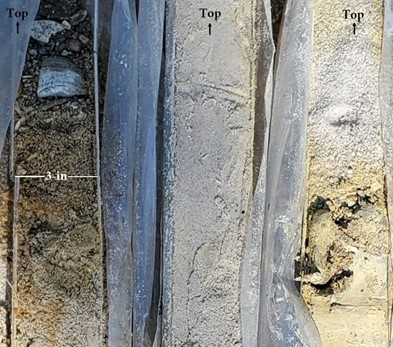
Example of lithological variation in offshore sediment collected from Sandbridge Shoal (vibracore).
To evaluate geochemistry and mineralogy for existing federal borrow/dredge areas, we examined and sampled previously-obtained vibracores from Sandbridge Shoal and the Atlantic Ocean Federal Navigation Channel offshore of Virginia Beach. We utilized a Humphreys 3-turn spiral (shown below) for gravity separation of these materials to create a pre-concentrate of high-density sands that were submitted to a laboratory for modal mineralogy. Details regarding the modal mineralogy are available in Appendix C of the Capacity Assessment. Additionally, we provide more information on economic heavy minerals in Virginia on the Critical Minerals webpage.

Three-turn Humphreys spiral concentrator used to separate denser minerals from lighter minerals; (B)-(C) magnification of a heavy mineral sand concentrate.
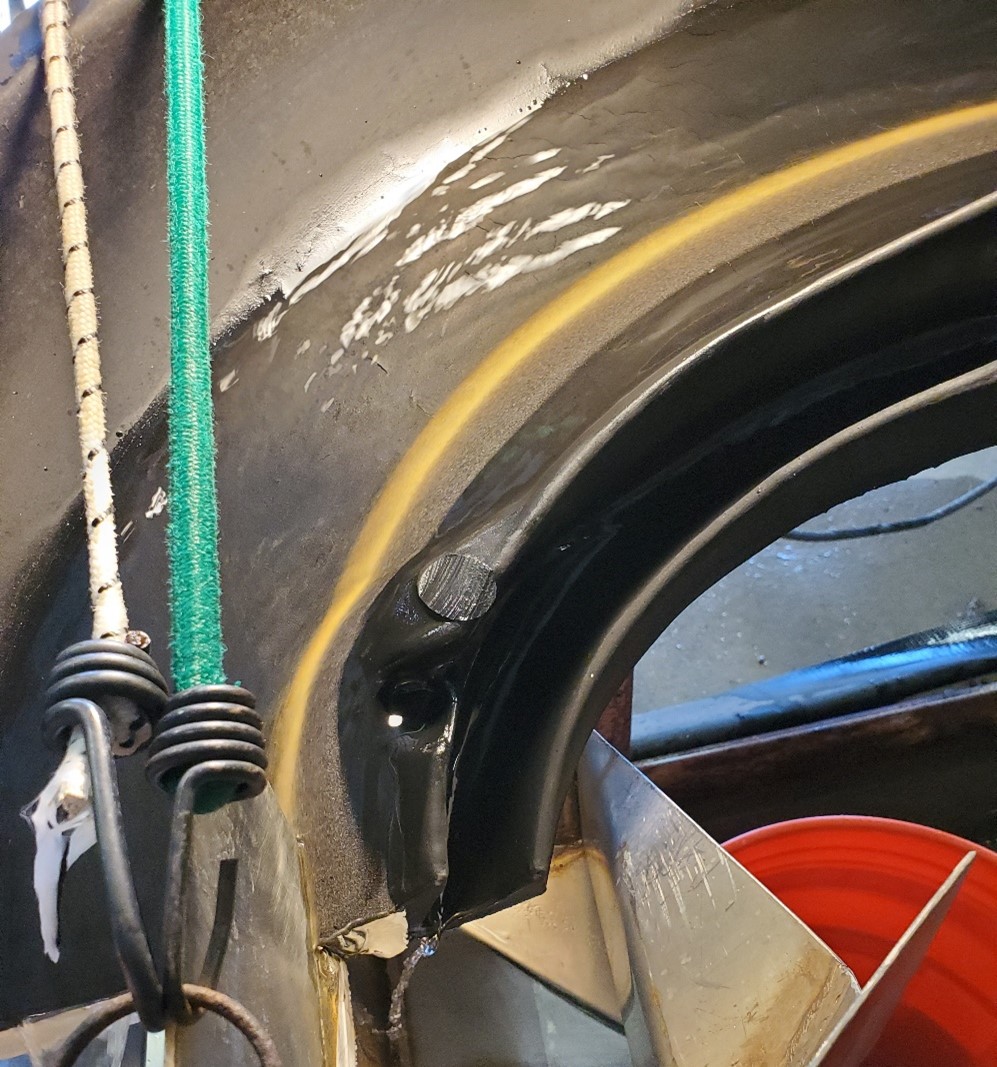
Visible separation of the lighter mineral fraction (i.e., quartz, feldspar) and heavier mineral fraction (i.e., ilmenite, zircon, etc.), conducted via gravity separation in the three-turn Humphreys spiral.
The pXRF screening protocol outlined the capacity assessment is based on available and accessible geochemical data and may be updated as more data is acquired. It highlights current best practices for identifying critical elements in heavy mineral sands from offshore sand resources. We recommend the evaluation of the elements related to ilmenite, rutile, zircon, and REE-bearing phosphates as these are the critical commodities at Sandbridge Borrow Areas and the Atlantic Ocean Federal Navigation Channel. Major elements present in these mineral concentrates are Fe, Ti and Zr, with trace amounts of La, Ce, Y, Sc, Nb and/or V. The scope is to provide efficient screening turnaround time, and to guide sampling for laboratory submittal for analytical geochemistry and mineralogy. This protocol is available in the capacity assessment with supplemental details in Appendix D and provides a discussion of general sampling and processing procedures (Figure 3). The protocol does not address specific x-ray certification, inspection, or training requirements of equipment manufacturers. The user should be familiar with elemental chemistry of specific minerals and/or rock material and understand the heterogeneity of the material being tested.
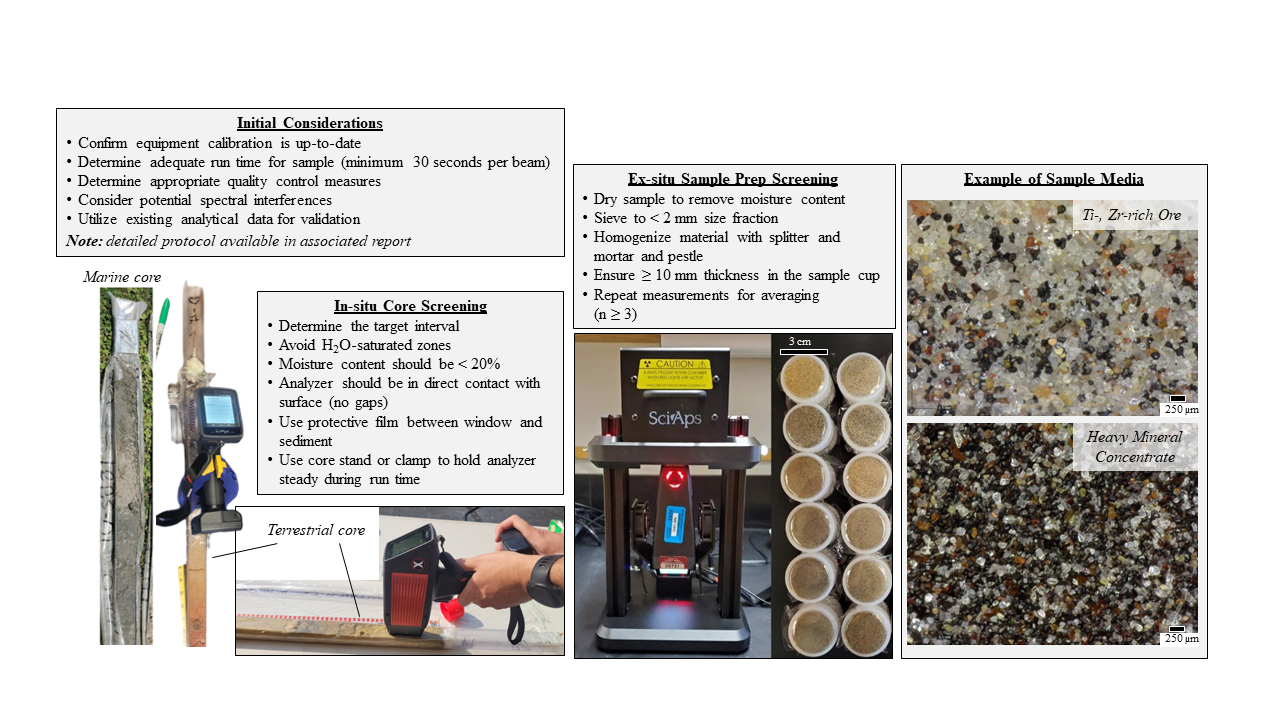
Figure 3: Generalized pXRF screening considerations for detecting critical commodities contained within offshore sand resources. Ex-situ sample pucks include packed sediment with a 4-micron thick prolene protective sheet.
Recommendations for a pilot study to test the feasibility of concentrating and further processing of heavy mineral sands at an inland facility alongside a beach nourishment project is scoped in Appendix E of the Capacity Assessment. These proposed next steps are meant to provide a starting point for potential future endeavors related to heavy mineral sand recovery from nourishment sands.
Deliverables »
- Open File Report 2024-16 - A capacity assessment on the recovery of critical and economic minerals from sand used for coastal resilience projects.
- Open File Report 2022-20 - Proceedings of the 2022 Mid-Atlantic Marine Heavy Mineral Sands Forum.
- Summary Report
- Geodatabase
Other Reports »
- Open File Report 2019-04 - Heavy mineral distributions in offshore sediments using Q-mode factor analysis.
- Open File Report 2019-03 - Economic heavy minerals on the continental shelf offshore of Virginia - new insights into the mineralogy, particle sizes, and critical element chemistry.
- Open File Report 2019-02 - Assessment of offshore sand resources for beach remediation in Virginia.
- Open File Report 16-01 - Grain size distribution and heavy mineral content of marine sands in Federal waters offshore of Virginia.
Acknowledgements
Funding for the sand and heavy mineral resource projects (open-file reports from 2016-2019) was provided by the U.S. Bureau of Ocean Energy Management (BOEM) under Cooperative Agreement M14AC00013 with additional funding from Virginia Energy. Funding for the capacity assessment study to assess recovery of economic minerals within marine sand deposits was provided by BOEM under Cooperative Agreement M21AC00010 with additional funding contributions from Virginia Energy. For more information about marine minerals on the Atlantic continental shelf, visit the BOEM web site.
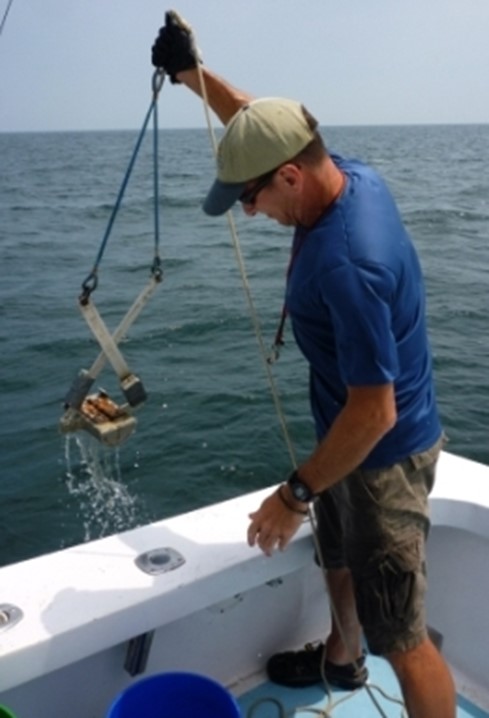
Billy Lassetter collecting a sediment surface grab sample offshore of Virginia for further analyses.
Selected References:
Berquist, C.R., Jr., and C.H. Hobbs, III, 1986, Assessment of economic heavy minerals of the Virginia inner shelf: Virginia Division of Mineral Resources Open File Report 86-1. 13 p. and appendices.
Berquist, C.R., Jr., and C.H. Hobbs, III, 1988, Study of economic heavy minerals of the Virginia inner continental shelf: Virginia Division of Mineral Resources Open File Report 88-4, 23 p. and appendices.
Berquist, C.R., Jr., [ed.], 1990, Heavy-mineral studies - Virginia inner continental shelf, Virginia Division of Mineral Resources Publication 103, 39 p. and appendices.
Berquist, C.R., Jr., [ed.], 2012, Heavy-mineral analysis of five samples: Addendum to sand resource evaluation on Virginia's outer continental shelf coastal plain - Final technical report: Prepared for U.S. Bureau of Ocean Energy Management, Cooperative Agreement M10AC20021 for the performance period Sept 14, 2010, to Oct 31, 2011: 2 p. and Appendices.
Berquist, C.R., Jr., Lassetter, W.L., and Goodwyn, M.H., 2016, Grain size distribution and heavy mineral content of marine sands in Federal waters offshore of Virginia: Virginia Division of Geology and Mineral Resources Open File Report 2016-01, 22 p. and appendices.
Berquist, C.R., Jr., and Boon, J.D., 2019, Heavy mineral distributions in offshore sediments using Q-mode factor analysis: Virginia Division of Mineral Resources Open File Report 2019-04, 35 p.
Blanchette, J.S., and Lassetter, W.L., 2019, Assessment of offshore sand resources for beach remediation in Virginia: Virginia Division of Geology and Mineral Resources Open File Report 2019-02, 24 p. and Appendices.
DMME (Department of Mines, Minerals and Energy), 2012, Sand resource evaluation on Virginia’s outer continental shelf - Final Technical Report: Prepared for U.S. Bureau of Ocean Energy Management, Cooperative Agreement M10AC20021 for the performance period Sept 14, 2010 to Oct 31, 2011: 19 p.
DMME (Department of Mines, Minerals and Energy), 2020, Annual Production data reported to the Division of Mineral Mining.
Goodwyn, M.H., Enomoto, M.R., Lassetter, W.L., and Kuehl, S.A., 2016, GIS compilation of geophysical data on Virginia’s Outer Continental Shelf: Division of Geology and Mineral Resources Open File Report 2016-02. 10 p. and appendices.
Hawkins, D.W., and Lassetter, W.L., 2022, Proceedings of the 2022 Mid-Atlantic Marine Heavy Mineral Sands Forum: Virginia Geology and Mineral Resources Program Open File Report 2022-20, 21 p. and Appendices.
Hawkins, D.W. and Lassetter, W.L., 2023. Standardizing A Field Screening Protocol Using Portable X-Ray Fluorescence and Radiation Spectrometry to Assess Critical Mineral Commodities in Heavy Mineral Placers: How Can We Better Streamline Decisions in The Field? Geological Society of America Abstracts with Programs. Vol. 55, No. 2. doi: 10.1130/abs/2023SE-385571.
Lassetter, W.L., and Blanchette, J.S., 2019, Economic heavy minerals on the continental shelf offshore of Virginia - new insights into the mineralogy, particle sizes, and critical element chemistry: Virginia Division of Geology and Mineral Resources Open File Report 2019-03, 33 pp and Appendices.
Lassetter, W.L. and Hawkins, D.W., 2022. Marine Mineral Sands on Virginia's Outer Continental Shelf - The Case for Extracting Critical Minerals as Part of Beach Restoration Projects. Geological Society of America Abstracts with Programs. Vol. 54, No. 5. doi: 10.1130/abs/2022AM-381889.
Milligan, D.A., Kuehl, S.A., and Hardaway, C.S., 2016, Digital conversion of geologic core data, quality control, and preliminary assessment of sand resource area on Virginia's Outer Continental Shelf: Virginia Institute of Marine Science, 14 p.
Nelson, M.S., Lassetter, W.L., and Hawkins, D.W., 2023. Heavy Mineral Sand Abundance and Mineralogy from Paleo-placer and Offshore Deposits in VA. 2023 Virginia Geological Research Symposium hosted by Virginia Department of Energy, Geology and Mineral Resources Program, Charlottesville, VA, April 21, 2023.
Nelson, M.S., Hawkins, D.W., and Lassetter, W.L., 2023. Economic Heavy Minerals in Sand Resources Offshore of Virginia: Geological Society of America Abstracts with Programs. Vol. 55, No. 6, 2023 doi: 10.1130/abs/2023AM-395679.
Other Resources:
Blanchette, J., and W.L. Lassetter, 2018, Marine mineral resources on Virginia's outer continental shelf: quantifying sand deposits for coastal restoration and occurrences of economic heavy minerals [abs]: Geological Society of America Northeastern Sectional Annual Meeting, 17-20 March 2018, Burlington, VT.
Lassetter, W.L., Blanchette, J.S., and Holm-Denoma, C., 2019, Marine mineral resources on the continental shelf offshore of Virginia: new insights concerning economic heavy minerals: [abs]: Geological Society of America Southeastern Sectional Annual Meeting, 28-29 March 2019, Charleston, SC.
